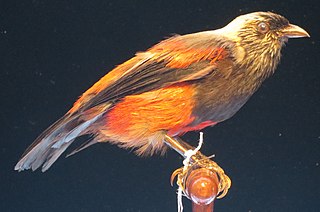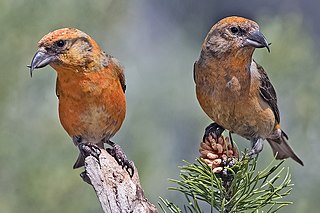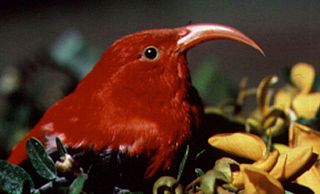
The true finches are small to medium-sized passerine birds in the family Fringillidae. Finches generally have stout conical bills adapted for eating seeds and nuts and often have colourful plumage. They occupy a great range of habitats where they are usually resident and do not migrate. They have a worldwide native distribution except for Australia and the polar regions. The family Fringillidae contains more than two hundred species divided into fifty genera. It includes the canaries, siskins, redpolls, serins, grosbeaks and euphonias, as well as the morphologically divergent Hawaiian honeycreepers.
Located about 2,300 miles (3,680 km) from the nearest continental shore, the Hawaiian Islands are the most isolated group of islands on the planet. The plant and animal life of the Hawaiian archipelago is the result of early, very infrequent colonizations of arriving species and the slow evolution of those species—in isolation from the rest of the world's flora and fauna—over a period of at least 5 million years. As a consequence, Hawai'i is home to a large number of endemic species. The radiation of species described by Charles Darwin in the Galapagos Islands which was critical to the formulation of his theory of evolution is far exceeded in the more isolated Hawaiian Islands.

The ʻula-ʻai-hāwane is an extinct species of small Hawaiian honeycreeper. The term ʻula-ʻai-hāwane is a Hawaiian phrase translating to "red [bird] that eats hāwane". It was only ever reported from the forested mountains of the Kohala, Hilo and Kona districts on the island of Hawaiʻi. Fossil remains reveal that it also existed at one time on other Hawaiian islands. The species is named after Anna Dole, wife of Sanford B. Dole.

The cardueline finches are a subfamily, Carduelinae, one of three subfamilies of the finch family Fringillidae, the others being the Fringillinae and the Euphoniinae. The Hawaiian honeycreepers are now included in this subfamily. Except for the Hawaiian honeycreepers which underwent adaptive radiation in Hawaii and have evolved a broad range of diets, cardueline finches are specialised seed eaters, and unlike most passerine birds, they feed their young mostly on seeds, which are regurgitated. Besides this, they differ from the other finches in some minor details of their skull. They are adept at opening seeds and clinging to stems, unlike other granivorous birds, such as sparrows and buntings, which feed mostly on fallen seeds. Some members of this subfamily are further specialised to feed on a particular type of seed, such as cones in the case of crossbills. Carduelines forage in flocks throughout the year, rather than keeping territories, and males defend their females rather than a territory or nest.

Akialoa is an extinct genus of Hawaiian honeycreeper in the subfamily Carduelinae of the family Fringillidae. The ʻakialoa species are all extinct, but they formerly occurred throughout Hawaii.
The highland finch is an extinct member of the Fringillidae and a Hawaiian honeycreeper which is known only from a few bones found in caves. It is the only member of the genus Orthiospiza. It was endemic to the high-elevation areas of Mount Haleakalā on the Hawaiian island of Maui. It has been speculated that they were pushed to extinction because of habitat loss. It is known only from fossil remains and likely became extinct before the first Europeans arrived in 1778.
The Kauai finch is an extinct bird in the genus Telespiza of the family Fringillidae. It was endemic to the Hawaiian islands of Kauai and Oahu. It is only known from fossil remains and likely became extinct before the first Europeans visited Hawaii in 1778.
The primitive koa finch is an extinct species of Hawaiian honeycreeper in the subfamily Carduelinae of the family Fringillidae. It is known from fossils on the islands of Maui and Oʻahu in Hawaii.
The King Kong grosbeak or giant grosbeak is a prehistoric species of Hawaiian honeycreeper, that was endemic to Hawaiʻi. It had the largest beak of the three Chloridops species known to have existed. The King Kong grosbeak was described from fossils found at Barber's Point and Ulupau Head on the island of Oʻahu. It was 11 inches (28 cm) long, making it one of the largest Hawaiian honeycreepers. The osteology of the mandible strongly suggests that C. regiskongi was a sister-taxon of Rhodacanthis.

The Laysan honeycreeper, also known as the Laysan ʻapapane or Laysan honeyeater, is an extinct species of finch that was endemic to the island of Laysan in the Northwestern Hawaiian Islands. The bird was first recorded in 1828 and in 1892 received its scientific name from Walter Rothschild, who placed it in the genus Himatione along with the ʻapapane. The specific name, fraithii, refers to George D. Freeth, the self-appointed governor of Laysan, but was misspelled. Rothschild attempted to emend it to freethi in a later publication. This was accepted by most subsequent authors throughout the 20th century, and the bird was also considered a subspecies of the ʻapapane, as H. sanguinea freethii, for most of this time. By the 21st century, after further research, the original name was reinstated and it was considered a full species again. As a Hawaiian honeycreeper, a grouping within the finch subfamily Carduelinae, its ancestors are thought to have come from Asia.
Xestospiza is an extinct genus of containing two species of Hawaiian honeycreeper with cone-shaped bills that were described on the basis of bones. They were possibly insectivores. It consists of the following:
The stout-legged finch is an extinct species of finch, in the 'Hawaiian honeycreeper' group. Subfossil remains have been found only on the island of Kauai and indicate that it survived up until the late Quaternary period. It probably died out when the first humans arrived in the Hawaiian Islands. The stout-legged finch would have been very vulnerable to the pests and agriculture that the humans brought with them. It was a congener of the 'ula-'ai-hawane, and therefore probably had similar colors of red, white and black.

Hawaiian honeycreepers are a group of small birds endemic to Hawaiʻi. They are members of the finch family Fringillidae, closely related to the rosefinches (Carpodacus), but many species have evolved features unlike those present in any other finch. Their great morphological diversity is the result of adaptive radiation in an insular environment. Many have been driven to extinction since the first humans arrived in Hawaii, with extinctions increasing over the last two centuries following European discovery of the islands, with habitat destruction and especially invasive species being the main causes.
The wood harrier or mime harrier is an extinct bird of prey which lived in Hawaii during the Holocene. This small, short-winged harrier inhabited the forests of Molokai and Oahu where it presumably hunted for small birds and insects.
Xestospiza fastigialis is an extinct species of bird with a ridge-shape bill that was described on the basis of fossils. It was possibly an insectivore, populating the Hawaiian Islands of Oahu, Molokai and Maui.
Xestospiza conica is an extinct species of bird with a cone-shaped bill that was described on the basis of fossils. It was possibly an insectivore, populating the Hawaiian Island of Kauai.






